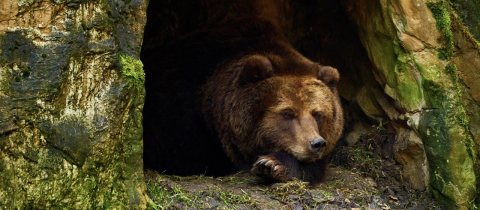Leafcutter ants can strip as much as 17% of the leaf biomass from plants in their ecosystem and can clear entire trees in under a day. Next to ours, leafcutter ant society is the most complex society on earth. They build nests that can contain thousands of rooms and cover up to 0.5 km2, a feat that is necessary since a mature colony can contain more than eight million individuals.
But if they’re not eating the leaves that they carry home, what are they doing with them?
Farming. Leafcutter ants use leaves as their fertilizer to grow their crop: fungus.
They cultivate their fungal gardens by providing them with freshly cut leaves, protecting them from pests and molds, and clearing them of decayed material and garbage. In return, the fungus acts as a food source for the ants' larvae. The ants are so sensitive to the fungi’s needs that they can detect how they are responding to a certain food source and change accordingly. This symbiotic relationship also benefits from a bacterium that grows on the ants’ bodies and secretes antimicrobials, which the ants use to protect their fungi.
Adult ants don’t feed on the fungus, but rather get their nutrients from leaf sap. Smaller adults often hitchhike on leaves being carried back to the nest to opportunistically feed on the sap, as well as protect the carrier from flies and to check that the leaf isn’t contaminated with other fungi.
Leafcutter ant society is divided into castes, with each group having a different role to play. The largest ants, called Majors, act as soldiers and heavy lifters. They guard the nest and help to clear out the highways between the nest and a food source. The next smallest caste, the Mediae, is made up of generalists, cutting and transporting the bulk of the leaves for their colony. Next in size are the Minors, who protect the foraging path and food source, and the smallest ants, the Minims, work exclusively at home, tending to the larvae and fungus garden.
Some Minims work exclusively as garbage collectors, removing decaying organic matter from their fungal gardens and transporting it to dedicated garbage rooms placed well below the rest of the nest. After becoming garbage collectors, these ants will never interact with the fungus or the queen, to prevent any disease from being passed onto them.
Leafcutter ants are often presented as a single species of ant, but in reality, there are 250 species of ants which practice fungus farming. Besides their agrarian tendencies, these ants have something else in common: queens. When it comes time to establish a new colony, winged virgin queens-to-be take part in their nuptial flight and mate with many different males to collect sperm. They then set out to find an appropriate place for a new colony, bringing with them a piece of the fungus to seed their new fungal gardens.
Want to comment on this article? Visit our FB Page!







